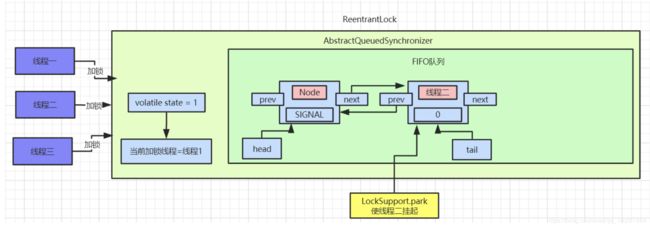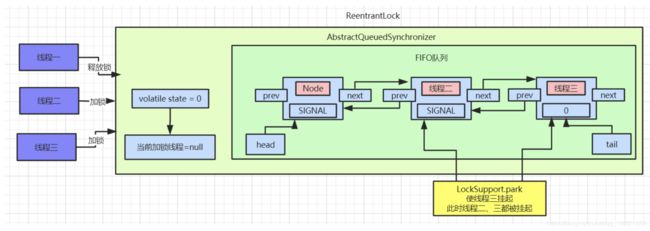深入理解AQS
1. AQS实现原理
AQS中维护了一个volatile int state(代表共享资源)和一个FIFO线程等待队列(多线程争用资源被阻塞时会进入此队列)。这里volatile能够保证多线程下的可见性,当state=1则代表当前对象锁已经被占有,其他线程来加锁时则会失败,加锁失败的线程会被放入一个FIFO的等待队列中,比列会被UNSAFE.park()操作挂起,等地其他获取锁的线程释放锁才能被唤醒。
另外state操作是通过CAS来保证并发修改的安全性。描述图
- getState():获取锁的标志state值
- setState():设置锁的标志state值
- tryAcquire(int):独占方式获取锁。尝试获取资源,成功则返回true,失败则返回false。
-
tryRelease(int):独占方式释放锁。尝试释放资源,成功则返回true,失败则返回false。
接下来我们以ReentrantLock作为突破点通过源码和画图的形式一步步了解AQS内部实现原理。
二、场景分析
线程一加锁成功
如果同时有三个线程并发抢占锁,此时线程一抢占锁成功,线程二和线程三抢占锁失败,具体执行流程如下:
此时AQS内部数据为:
线程二、线程三加锁失败:
有图可以看出,等待队列中的节点Node是一个双向链表,这里SIGNAL是Node中waitStatus属性,Node中还有一个nextWaiter属性,这个并未在图中画出来,这个到后面Condition会具体讲解的。具体看下抢占锁代码实现:
static final class NonfairSync extends Sync {
final void lock() {
if (compareAndSetState(0, 1))
setExclusiveOwnerThread(Thread.currentThread());
else
acquire(1);
}
protected final boolean tryAcquire(int acquires) {
return nonfairTryAcquire(acquires);
}
}这里使用的ReentrantLock非公平锁,线程进来直接利用CAS尝试抢占锁,如果抢占成功state值被改为1,且设置对象独占锁线程为当前线程。如下所示:
protected final boolean compareAndSetState(int expect, int update) {
return unsafe.compareAndSwapInt(this, stateOffset, expect, update);
}
protected final void setExclusiveOwnerThread(Thread thread) {
exclusiveOwnerThread = thread;
}线程二抢占锁失败
我们按照真实场景来分析,线程一抢占锁成功后,state变为1,线程二通过CAS修改state变量必然会失败。此时AQS中FIFO(First In First Out 先进先出)队列中数据如图所示:
我们将线程二执行的逻辑一步步拆解来看:
public final void acquire(int arg) {
if (!tryAcquire(arg) &&
acquireQueued(addWaiter(Node.EXCLUSIVE), arg))
selfInterrupt();
}先看看tryAcquire()的具体实现:
final boolean nonfairTryAcquire(int acquires) {
final Thread current = Thread.currentThread();
int c = getState();
if (c == 0) {
if (compareAndSetState(0, acquires)) {
setExclusiveOwnerThread(current);
return true;
}
}
else if (current == getExclusiveOwnerThread()) {
int nextc = c + acquires;
if (nextc < 0)
throw new Error("Maximum lock count exceeded");
setState(nextc);
return true;
}
return false;
}nonfairTryAcquire()方法中首先会获取state的值,如果不为0则说明当前对象的锁已经被其他线程所占有,接着判断占有锁的线程是否为当前线程,如果是则累加state值,这就是可重入锁的具体实现,累加state值,释放锁的时候也要依次递减state值。
如果state为0,则执行CAS操作,尝试更新state值为1,如果更新成功则代表当前线程加锁成功。
以线程二为例,因为线程一已经将state修改为1,所以线程二通过CAS修改state的值不会成功。加锁失败。
线程二执行tryAcquire()后会返回false,接着执行addWaiter(Node.EXCLUSIVE)逻辑,将自己加入到一个FIFO等待队列中,代码实现如下:
private Node addWaiter(Node mode) {
Node node = new Node(Thread.currentThread(), mode);
Node pred = tail;
if (pred != null) {
node.prev = pred;
if (compareAndSetTail(pred, node)) {
pred.next = node;
return node;
}
}
enq(node);
return node;
}这段代码首先会创建一个和当前线程绑定的Node节点,Node为双向链表。此时等待对内中的tail指针为空,直接调用enq(node)方法将当前线程加入等待队列尾部:
private Node enq(final Node node) {
for (;;) {
Node t = tail;
if (t == null) {
if (compareAndSetHead(new Node()))
tail = head;
} else {
node.prev = t;
if (compareAndSetTail(t, node)) {
t.next = node;
return t;
}
}
}
}第一遍循环时tail指针为空,进入if逻辑,使用CAS操作设置head指针,将head指向一个新创建的Node节点。此时AQS中数据:
执行完成之后,head、tail、t都指向第一个Node元素。接着执行第二遍循环,进入else逻辑,此时已经有了head节点,这里要操作的就是将线程二对应的Node节点挂到head节点后面。此时队列中就有了两个Node节点:
addWaiter()方法执行完后,会返回当前线程创建的节点信息。继续往后执行acquireQueued(addWaiter(Node.EXCLUSIVE), arg)逻辑,此时传入的参数为线程二对应的Node节点信息:
final boolean acquireQueued(final Node node, int arg) {
boolean failed = true;
try {
boolean interrupted = false;
for (;;) {
final Node p = node.predecessor();
if (p == head && tryAcquire(arg)) {
setHead(node);
p.next = null; // help GC
failed = false;
return interrupted;
}
if (shouldParkAfterFailedAcquire(p, node) &&
parkAndChecknIterrupt())
interrupted = true;
}
} finally {
if (failed)
cancelAcquire(node);
}
}
private static boolean shouldParkAfterFailedAcquire(Node pred, Node node) {
int ws = pred.waitStatus;
if (ws == Node.SIGNAL)
return true;
if (ws > 0) {
do {
node.prev = pred = pred.prev;
} while (pred.waitStatus > 0);
pred.next = node;
} else {
compareAndSetWaitStatus(pred, ws, Node.SIGNAL);
}
return false;
}
private final boolean parkAndCheckInterrupt() {
LockSupport.park(this);
return Thread.interrupted();
}acquireQueued()这个方法会先判断当前传入的Node对应的前置节点是否为head,如果是则尝试加锁。加锁成功过则将当前节点设置为head节点,然后空置之前的head节点,方便后续被垃圾回收掉。
如果加锁失败或者Node的前置节点不是head节点,就会通过shouldParkAfterFailedAcquire方法 将head节点的waitStatus变为了SIGNAL=-1,最后执行parkAndChecknIterrupt方法,调用LockSupport.park()挂起当前线程。
此时AQS中的数据如下图:
此时线程二就静静的待在AQS的等待队列里面了,等着其他线程释放锁来唤醒它。
线程三抢占锁失败
看完了线程二抢占锁失败的分析,那么再来分析线程三抢占锁失败就很简单了,先看看addWaiter(Node mode)方法:
private Node addWaiter(Node mode) {
Node node = new Node(Thread.currentThread(), mode);
Node pred = tail;
if (pred != null) {
node.prev = pred;
if (compareAndSetTail(pred, node)) {
pred.next = node;
return node;
}
}
enq(node);
return node;
}此时等待队列的tail节点指向线程二,进入if逻辑后,通过CAS指令将tail节点重新指向线程三。接着线程三调用enq()方法执行入队操作,和上面线程二执行方式是一致的,入队后会修改线程二对应的Node中的waitStatus=SIGNAL。最后线程三也会被挂起。此时等待队列的数据如图:
线程一释放锁
现在来分析下释放锁的过程,首先是线程一释放锁,释放锁后会唤醒head节点的后置节点,也就是我们现在的线程二,具体操作流程如下:
执行完后等待队列数据如下:
此时线程二已经被唤醒,继续尝试获取锁,如果获取锁失败,则会继续被挂起。如果获取锁成功,则AQS中数据如图:
接着还是一步步拆解来看,先看看线程一释放锁的代码:
java.util.concurrent.locks.AbstractQueuedSynchronizer.release()
public final boolean release(int arg) {
if (tryRelease(arg)) {
Node h = head;
if (h != null && h.waitStatus != 0)
unparkSuccessor(h);
return true;
}
return false;
}这里首先会执行tryRelease()方法,这个方法具体实现在ReentrantLock中,如果tryRelease执行成功,则继续判断head节点的waitStatus是否为0,前面我们已经看到过,head的waitStatue为SIGNAL(-1),这里就会执行unparkSuccessor()方法来唤醒head的后置节点,也就是我们上面图中线程二对应的Node节点。
此时看ReentrantLock.tryRelease()中的具体实现:
protected final boolean tryRelease(int releases) {
int c = getState() - releases;
if (Thread.currentThread() != getExclusiveOwnerThread())
throw new IllegalMonitorStateException();
boolean free = false;
if (c == 0) {
free = true;
setExclusiveOwnerThread(null);
}
setState(c);
return free;
}执行完ReentrantLock.tryRelease()后,state被设置成0,Lock对象的独占锁被设置为null。此时看下AQS中的数据:
接着执行java.util.concurrent.locks.AbstractQueuedSynchronizer.unparkSuccessor()方法,唤醒head的后置节点:
private void unparkSuccessor(Node node) {
int ws = node.waitStatus;
if (ws < 0)
compareAndSetWaitStatus(node, ws, 0);
Node s = node.next;
if (s == null || s.waitStatus > 0) {
s = null;
for (Node t = tail; t != null && t != node; t = t.prev)
if (t.waitStatus <= 0)
s = t;
}
if (s != null)
LockSupport.unpark(s.thread);
}这里主要是将head节点的waitStatus设置为0,然后解除head节点next的指向,使head节点空置,等待着被垃圾回收。此时重新将head指针指向线程二对应的Node节点,且使用LockSupport.unpark方法来唤醒线程二。被唤醒的线程二会接着尝试获取锁,用CAS指令修改state数据。执行完成后可以查看AQS中数据:
此时线程二被唤醒,线程二接着之前被park的地方继续执行,继续执行acquireQueued()方法。













